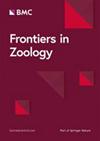基底动物软骨颅骨发育的序列——让我们做一个头盖骨
IF 2.6
2区 生物学
Q1 ZOOLOGY
引用次数: 1
摘要
颅面骨骼是脊椎动物的进化创新。由于其复杂性和重要性,以保护大脑和帮助基本功能(如进食),它的发展需要一个精确调整的软骨化和/或骨化事件序列。软骨形成的顺序模式的比较对发展的演变具有重要的见解。大舌龙是一种基生无脊椎动物。将其软骨颅骨(软骨神经和内脏)发育与其他基础无尾动物(爪蟾,东方bomina orientalis)进行比较,将有助于建立无尾动物软骨化序列的祖先模式,并为进一步研究重建两栖动物、四足动物和脊椎动物的祖先条件奠定基础。此外,一旦祖先序列确定,无尾动物的进化模式就可以根据适应性来研究。我们对D. scovazzi软骨头盖骨的发育进行了全面的综述。通过清除和染色,组织学和3D重建,我们追踪了44个软骨细胞的软骨化,从第一个间充质胶原到预变质软骨头部骨骼,并说明了颅骨的顺序变化。我们发现了软骨发育的一些无骨和舌骨样特征。在D. scovazzi中,下颌弓、舌骨弓和第一鳃弓首先形成角原,然后逐步增加II、III和IV鳃弓。尽管如此,在D. scovazzi的内脏中没有严格的前后软骨形成模式。单个舌骨弓的软骨在鳃弓的软骨后形成,下颌弓的软骨在鳃弓的软骨后形成。在骨鱼类中,神经颅骨的软骨在前后方向发育。在迄今为止所研究的无尾目动物中,以及在D. scovazzi中,神经头盖骨的后部向前延伸,而神经头盖骨的前部向后延伸,直到两个部分相遇并融合。Anuran软骨发育至少在两个关键特征上与其他颌口动物不同,这进一步支持了对这一进化分支进行更多发育研究的迫切需要,以了解脊椎动物软骨发育的进化。本文章由计算机程序翻译,如有差异,请以英文原文为准。
Sequence of chondrocranial development in basal anurans—Let’s make a cranium
The craniofacial skeleton is an evolutionary innovation of vertebrates. Due to its complexity and importance to protect the brain and aid in essential functions (e.g., feeding), its development requires a precisely tuned sequence of chondrification and/or ossification events. The comparison of sequential patterns of cartilage formation bears important insights into the evolution of development. Discoglossus scovazzi is a basal anuran species. The comparison of its chondrocranium (cartilaginous neuro- & viscerocranium) development with other basal anurans (Xenopus laevis, Bombina orientalis) will help establishing the ancestral pattern of chondrification sequences in anurans and will serve as basis for further studies to reconstruct ancestral conditions in amphibians, tetrapods, and vertebrates. Furthermore, evolutionary patterns in anurans can be studied in the light of adaptations once the ancestral sequence is established. We present a comprehensive overview on the chondrocranium development of D. scovazzi. With clearing and staining, histology and 3D reconstructions we tracked the chondrification of 44 elements from the first mesenchymal Anlagen to the premetamorphic cartilaginous head skeleton and illustrate the sequential changes of the skull. We identified several anuran and discoglossoid traits of cartilage development. In D. scovazzi the mandibular, hyoid, and first branchial arch Anlagen develop first followed by stepwise addition of the branchial arches II, III, and IV. Nonetheless, there is no strict anterior to posterior chondrification pattern within the viscerocranium of D. scovazzi. Single hyoid arch elements chondrify after elements of the branchial arch and mandibular arch elements chondrify after elements of the branchial arch I. In Osteichthyes, neurocranial elements develop in anterior to posterior direction. In the anurans investigated so far, as well as in D. scovazzi, the posterior parts of the neurocranium extend anteriorly, while the anterior parts of the neurocranium, extend posteriorly until both parts meet and fuse. Anuran cartilaginous development differs in at least two crucial traits from other gnathostomes which further supports the urgent need for more developmental investigations among this clade to understand the evolution of cartilage development in vertebrates.
求助全文
通过发布文献求助,成功后即可免费获取论文全文。
去求助
来源期刊

Frontiers in Zoology
ZOOLOGY-
CiteScore
4.90
自引率
0.00%
发文量
29
审稿时长
>12 weeks
期刊介绍:
Frontiers in Zoology is an open access, peer-reviewed online journal publishing high quality research articles and reviews on all aspects of animal life.
As a biological discipline, zoology has one of the longest histories. Today it occasionally appears as though, due to the rapid expansion of life sciences, zoology has been replaced by more or less independent sub-disciplines amongst which exchange is often sparse. However, the recent advance of molecular methodology into "classical" fields of biology, and the development of theories that can explain phenomena on different levels of organisation, has led to a re-integration of zoological disciplines promoting a broader than usual approach to zoological questions. Zoology has re-emerged as an integrative discipline encompassing the most diverse aspects of animal life, from the level of the gene to the level of the ecosystem.
Frontiers in Zoology is the first open access journal focusing on zoology as a whole. It aims to represent and re-unite the various disciplines that look at animal life from different perspectives and at providing the basis for a comprehensive understanding of zoological phenomena on all levels of analysis. Frontiers in Zoology provides a unique opportunity to publish high quality research and reviews on zoological issues that will be internationally accessible to any reader at no cost.
The journal was initiated and is supported by the Deutsche Zoologische Gesellschaft, one of the largest national zoological societies with more than a century-long tradition in promoting high-level zoological research.
 求助内容:
求助内容: 应助结果提醒方式:
应助结果提醒方式:


